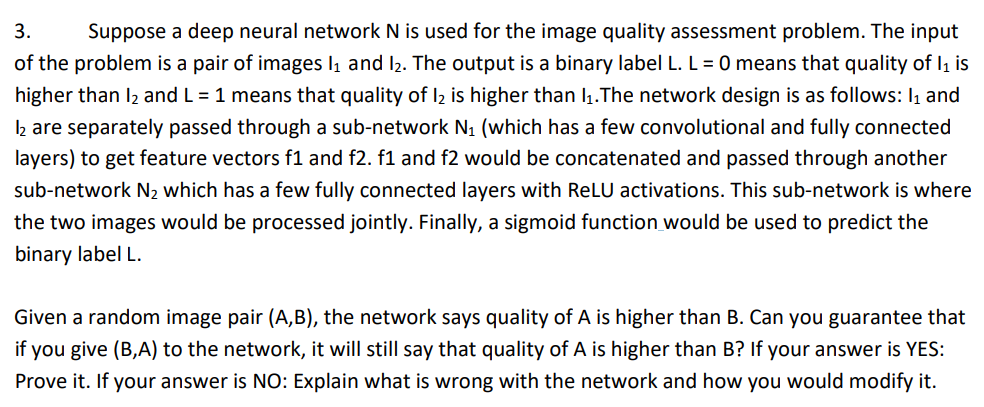3. Suppose a deep neural network N is used for the image quality assessment problem. The input of the problem is a pair of images 1₁ and 1₂. The output is a binary label L. L = 0 means that quality of 1₁ is higher than 12 and L = 1 means that quality of l₂ is higher than 1₁. The network design is as follows: 1₁ and 1₂ are separately passed through a sub-network N₁ (which has a few convolutional and fully connected layers) to get feature vectors f1 and f2. f1 and f2 would be concatenated and passed through another sub-network N₂ which has a few fully connected layers with ReLU activations. This sub-network is where the two images would be processed jointly. Finally, a sigmoid function would be used to predict the binary label L. Given a random image pair (A,B), the network says quality of A is higher than B. Can you guarantee that if you give (B,A) to the network, it will still say that quality of A is higher than B? If your answer is YES: Prove it. If your answer is NO: Explain what is wrong with the network and how you would modify it.
3. Suppose a deep neural network N is used for the image quality assessment problem. The input of the problem is a pair of images 1₁ and 1₂. The output is a binary label L. L = 0 means that quality of 1₁ is higher than 12 and L = 1 means that quality of l₂ is higher than 1₁. The network design is as follows: 1₁ and 1₂ are separately passed through a sub-network N₁ (which has a few convolutional and fully connected layers) to get feature vectors f1 and f2. f1 and f2 would be concatenated and passed through another sub-network N₂ which has a few fully connected layers with ReLU activations. This sub-network is where the two images would be processed jointly. Finally, a sigmoid function would be used to predict the binary label L. Given a random image pair (A,B), the network says quality of A is higher than B. Can you guarantee that if you give (B,A) to the network, it will still say that quality of A is higher than B? If your answer is YES: Prove it. If your answer is NO: Explain what is wrong with the network and how you would modify it.
Related questions
Question

Transcribed Image Text:3. Suppose a deep neural network N is used for the image quality assessment problem. The input
of the problem is a pair of images 1₁ and 12. The output is a binary label L. L = 0 means that quality of 1₁ is
higher than l₂ and L = 1 means that quality of l2 is higher than 1₁.The network design is as follows: 1₁ and
1₂ are separately passed through a sub-network N₁ (which has a few convolutional and fully connected
layers) to get feature vectors f1 and f2. f1 and f2 would be concatenated and passed through another
sub-network N₂ which has a few fully connected layers with ReLU activations. This sub-network is where
the two images would be processed jointly. Finally, a sigmoid function would be used to predict the
binary label L.
Given a random image pair (A,B), the network says quality of A is higher than B. Can you guarantee that
if you give (B,A) to the network, it will still say that quality of A is higher than B? If your answer is YES:
Prove it. If your answer is NO: Explain what is wrong with the network and how you would modify it.
Expert Solution
This question has been solved!
Explore an expertly crafted, step-by-step solution for a thorough understanding of key concepts.
This is a popular solution!
Trending now
This is a popular solution!
Step by step
Solved in 3 steps
